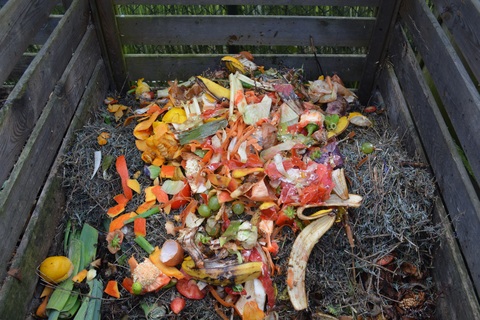What do I do with…?
Food
What is wasted food? Any food or compostable material that is not consumed (by humans or animals) or composted is wasted food. Wide consensus exists that reducing wasted food is one of the easiest and most effective ways to move to Zero Waste and address climate change.
Why is food waste a problem? Wasted food is excessive, expensive, and environmentally harmful. Reducing it can put food and money back into our community, improve food security, save the energy embodied in food, and reduce social & environmental impacts caused by the 133 billion pounds of food wasted every year in the United States.
Food in landfills creates landfill gas, which is rich in methane—a greenhouse gas many times more potent than carbon dioxide and a key driver of climate change. Even in state-of-the-art landfills designed to capture landfill gas, these gases often escape into the atmosphere before the gas capture system can capture it. The EPA food recovery hierarchy provides a very useful model for addressing waste food.
Examples: Food scraps, uneaten food, surplus food, donated food, food-soiled paper, cardboard, pizza box, compostable containers, compostable utensils
Reduce
Eat food before it goes bad
Be aware of portion sizes and expiration dates – don’t over-buy or over-cook
Eat leftovers
Practice fermentation to use up veggie parts you wouldn’t normally eat
Choose to purchase foods with less packaging
More food waste reduction tips here
Reuse
Choose reusable instead of single-use containers
Donate unused food items to Missoula Food Bank
Check out the most needed food items here
Donate scraps and unused food to animal sanctuaries
Recycle
Compost your wasted food
Baker Commodities & Mountain West Renewables take used cooking oil, mainly from restaurants or larger facilities
Missoula Compost Collection offers curbside collection service
Acceptable materials include: fruit and vegetable scraps, breads and grains, coffee grounds and tea bags, eggs (yolks, whites, & shells), meat & dairy products, compostable containers
Garden City Compost is a drop-off facility
Acceptable materials include: all food scraps, food-soiled paper, and BPI-certified compostable service ware (plates, cups, bags, utensils, etc.)
Recycling Works offers curbside collection service
Acceptable materials include: all food waste besides meat, grease, and garbage
Soil Cycle offers curbside collection service
Acceptable materials include: vegetables (raw/cooked), fruits, coffee grounds & filters, loose leaf tea, mushrooms, bread and grains, cereal, egg shells, plant and flower trimmings, shredded Paper (not glossy), used paper towels & napkins, pet hair
More about wasted food & other organic waste
Each year in the United States, we waste 35 million tons of food scraps, 14 million tons of yard trimmings, 13 million tons of soiled paper, and 13 million tons of wood debris. Instead of making compost, a beneficial soil amendment, 75 million tons of organic matter is burned or landfilled each year. Meanwhile, 99 million acres (28%) of US cropland face depletion of nutrients needed to maintain productivity.
Compostable organic materials are the largest component of municipal solid waste (MSW), with yard trimmings and food scraps accounting for 28% of the total. Food scraps make up 14.5% of MSW but only 2% of materials diverted from landfills (EPA).
Benefits of Composting
Food scraps and yard trimmings are valuable resources that can improve soil fertility and structure and stimulate healthy root development in plants. Small-scale composting is simple and easy. You can start with just leaves and grasses and eventually add food scraps. Composting also saves money you may spend on chemical fertilizers or commercial compost, and may reduce waste management costs.
For businesses, composting can positively impact your bottom line. Missoula’s Spirit at Play early childhood program saved over $140 per year in waste management costs after adding composting to all of their classrooms. For many companies, providing on-site composting will engage and inspire employees to higher levels of loyalty, satisfaction, productivity, and customer service. Today’s workers want to know that they, and you, are part of the solution.
What Happens to Sewer Waste?
Our municipal sewer system is an elegant waste collection system. Everything that goes down the drain, including street runoff and pulverized food scraps, ends up at the wastewater treatement plant (WWTP). Aerobic digestion and other processes are used to break down wastes. The results are 1) reclaimed water used to irrigate the Hybrid Poplar Tree Project, 2) methane captured and converted to electricity to meet much on-site power demands, and 3) sewage sludge used as compost feedstock at Garden City Compost, located adjacent to the WWTP.
Why Squash Doesn’t Compost in a Landfill
If you thought that spoiled, squishy, local squash would easily degrade in the landfill, think again. Landfills are not aerobic, that is they do not contain oxygen. When food scraps and yard trimmings are buried in a landfill they begin to rot and decay. A byproduct of decomposition in an oxygen-starved environment is methane, a greenhouse gas that causes climate change.
NASA recently discovered that methane is as much as 105 times more potent than CO2 as a greenhouse gas when compared over a 20-year time frame. The EPA states that landfills are the third-largest source of human-related methane emissions in the United States, accounting for approximately 18.2 percent of these emissions in 2012. That means our trash could be a bigger climate polluter than our cars and trucks!
~ Modified from Sustainable Business Council. Moving Missoula Toward Zero Waste Guide. 2015.
Resources:
ReFed - formed to build a different future, where food waste prevention is recognized as an untapped strategy that can save resources, create jobs, alleviate hunger, conserve water, and reduce greenhouse gas emissions — all while stimulating a new multi-billion dollar market opportunity.

